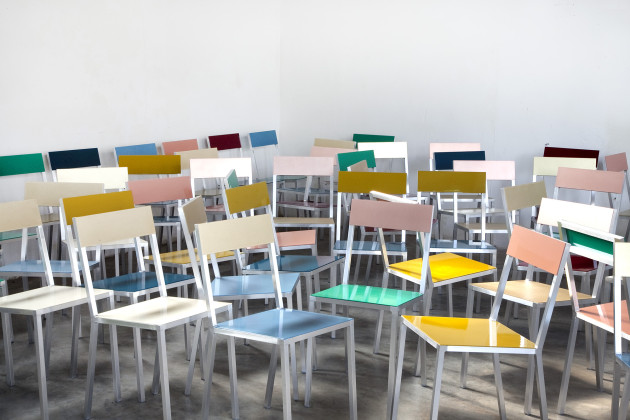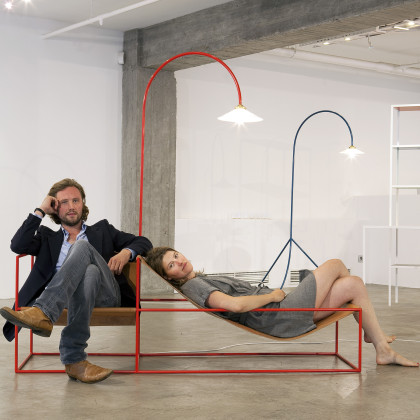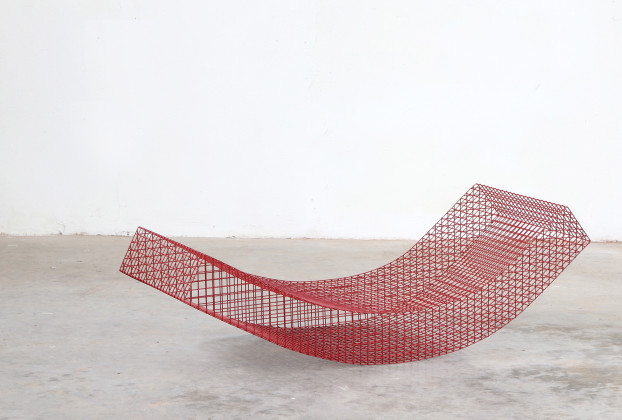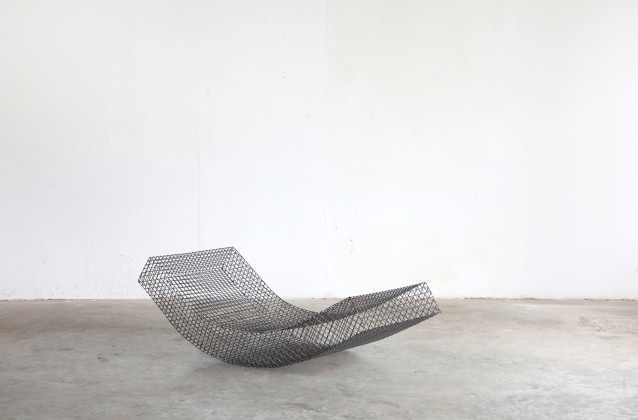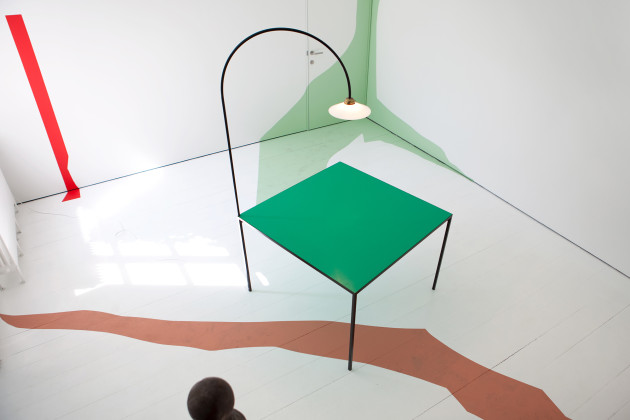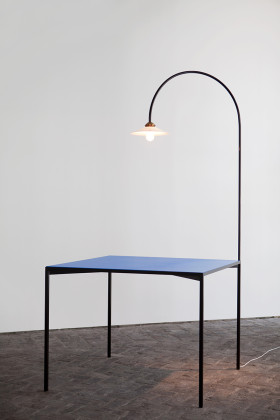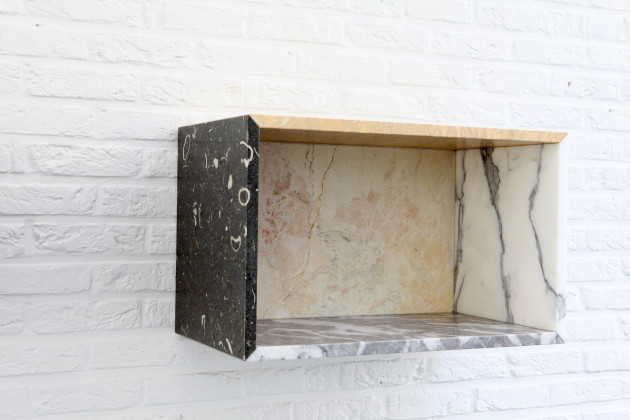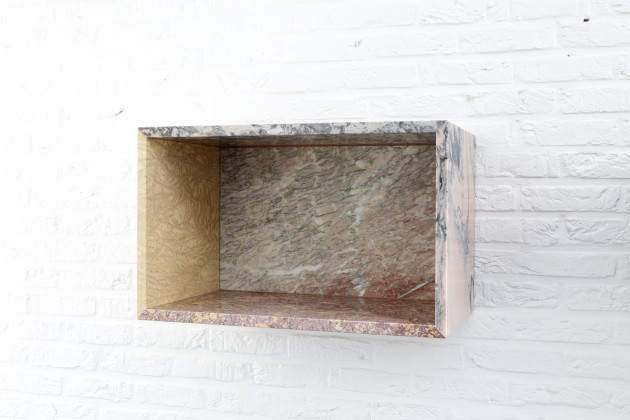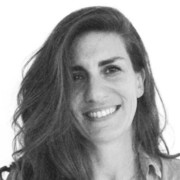On Sculpting Objects
Fien Muller and Hannes van Severen explain their own methods to design and produce with a principle which lets the designers to rethink an existing space
In an interview conducted by Asli Çiçek for XXI, Fien Muller and Hannes van Severen, the founders of Muller van Severen, explain their own methods to design and produce with a principle which lets the designers to rethink an existing space.
Aslı Çiçek: Before Muller Van Severen started you both pursued individually your paths in arts. Have you ever worked together prior to this collaboration?
Fien Muller: Muller Van Severen is our joint project, which began in 2011. But we know each other already a long time, since our studies at the Royal Academy for Fine Arts in Ghent, Belgium. Throughout the years we followed each other’s work very closely. Until our furniture project we had not worked together but were thinking of that now and then. Our artistic works have parallels but are highly individual, also influenced by our training and backgrounds.
AÇ: How do these backgrounds and trainings effect your collaboration and designs?
FM: I first studied photography and afterwards sculpture. Later I focused more on photography. My artwork is mostly based on compositions with as- found objects. With them I aim to create certain atmospheres on my photographs, which perhaps could trigger an idea of space. However, my artistic training is based upon ‘making’ things, objects, projects etc and this attitude I carried on to my compositions on my photographs. Making a composition with the as- found objects interested me more than to photograph an existing world.
Hannes Van Severen: I have been trained in sculpture and sticked to this medium. Sculpting is essential to my artwork, as well as the direct translation from the drawing to the third dimension. Nonetheless I shared most of Fien’s interests concerning her works. I transformed as- found objects into new sculptures with, sometimes, architectural connotations. Next to these works I also made sculptures that I configured in existing spaces. This is where we often met each other, there was this profound interest in intervening in the existing space, to direct the attention of the spectator to a certain element of that space, a floor, ceiling, wall or simply a corner. Fien’s photographs were aiming the same, through framing and composition of the elements she used. On the other hand I think the way I grew up plays also a role in my interest in making things. In my family making is part of everyone’s work and art or architecture has been not only seen in conceptual terms. If you grew up in a surrounding where objects are made or chosen with care, precision and attention, you often take that as an attitude towards your own work. FM: Our respective backgrounds have indeed an effect on our work in general. Other than Hannes I come from a family which is deeply involved antique world. Collecting objects carefully, watching them and defining their qualities are part of that context. I have a ‘baroque’ side coming from that background: an interest in composition through which I can direct the attention of the spectator to a precise moment. It might sound abstract at first how our backgrounds demonstrate themselves in our work, but we think the marble box we made as part of the first edition is a good example of that. We are not interested in visual purity, minimalism or aesthetics. Here the richness of marble patterns gives body to the shelf while the sharp corners and simple shape make it to a precise object which has a presence in space.
AÇ: This is a piece that belongs to your first edition presented at Gallery Valerie Traan in Antwerp, right?
FM: Yes. We made this piece upon request of the gallery owner, Veerle Wenes, who invited us both to make a project together. Veerle didn’t ask us to make furniture or functional objects necessarily. She invited people to work with artists who inspire them. It was a good opportunity because it gave us the space to think something together. It also coincided with the period when we just had moved into our new house with an adjacent atelier. We had to renovate the building, didn’t have electricity in the house and needed a lamp above our head so to speak… So came the idea of the table with a lamp attached to it. It was not necessarily pure functionality which interested us; once we made our first prototype we were also intrigued by the presence of such a simple element in the space.
AÇ: Did you also produce many drawings before you realised the first prototype?
HVS: We made drawings with this idea of combining functions in one piece and very quickly we started to test them in real scale. As we explained it just before the translation from two dimensional thoughts into third dimension of objects is essential for us. If you watch our drawings, like the one for the first show at Valerie Traan, you will see that there is not much difference between the first drawing and the final object. We made a sketch with lamps to define our installation and later on this became one of the few iconic images for our work.
AÇ: In my view, the materiality of your objects also help to preserve the elegance of these drawings…
HVS: The importance of ‘making’ is indeed supported through materials we discovered and chose, like brass and polyethylene. The latter intrigued us very much. It is a material from food industry, has its own logic in the existing fourteen standard colours for instance. We liked the functionality of this material concerning hygiene and symbolism connected to practicalities of food industry. The colors had their symbolic justifications such as the saturated blue to be used for cutting fish, red for meat, yellow to prepare them etc. Polyethylene is a very honest material, colored in mass and actually could be used as a surface for less challenging functions like a table top. We found that we could combine the colors in the simple form of our table- shelf and make something uncomplicated yet playful out of it. Brass is also a material which is strong, standard and rewarding to work with. We used these two materials to make our first object, the table- shelf. Fien’s approach to the configuration of different elements on her photographs played a big role in this as well as my landscape- like compositions with the sculptures I have been making until then.
AÇ: Do you prefer to work with standard materials to be found in the market or are you developing often new materials?
FM: Actually we understood the exhibition at the gallery as a combination of our earlier individual works, which always had the principle of working with existing or as- found elements. We looked for standard profiles in the market to use them in simple interventions to change the space immediately. Perhaps this strategy involved the economy of means as well and also helped us to act fast, make things directly, to step out of the paper zone into the workshop. We are not very strong in computer drawings and making models but we aim to reach good, useful results of our ideas. The use of existing profiles or standard materials was the best approach to create atmospheres that would be familiar with our individual works. Nonetheless was all of this not as conscious as we talk about it now. The process was rather an evident evolution from our working attitude.
HVS: So we took, for instance, a 16 mm metal tube for the lamps and looked for ways of bending it to reach the image we had on our sketch for the exhibition space. Fien always made drawings before she would make the compositions in front of the camera. In my work I tried to touch all corners of space, independent from directions and with the scattering of the lamps in the space also this approach came back. We followed these principles and looked for ways to realize the lamp without changing the overall image the sketch communicated. Ultimately we made a drawing in the space, so to speak. But when you translate the simple drawing into reality you also start to search for details that wouldn’t undermine or cheat the honesty of the drawing. The detail to hang the lamps on the wall was crucial to keep the image, hence we went to look for simple elements again and chose to use clips for hanging radiator tubes. The combination of these pieces with the tubes proved efficient and direct. We could have also been busy with designing special pieces, moulding or casting them, but all of that effort would have contradict with our working methods.
AÇ: Were you scared or limited because of having to consider functionality of furniture since you both come from plastic and visual arts where functionality is not a criterium at all?
FM: In fact, functionality of the furniture liberated us. We were rather relieved that we had this boundary. In our own work the functionality is indeed not an issue but once you take the challenge of furniture you cannot ignore its functionality. Our pieces might appeal to the contemporary or reduced aesthetics but we are very concerned with their functionality as well. By making the pieces in our workshop we could also test their proportions and potential as objects to use, we had this direct relation to them. For instance in table-lamp, the proportion from of the frivolous lamp to the more rigid square- geometry of the table was very important, as well as its position that had to let the light shine exactly in the middle above the table top. The production process was very personal too, almost intimate if you want. We made them ourselves, welding, cutting, polishing, actually ‘sculpting’ them in our own surrounding. This remains an important aspect of what we do although we don’t always keep all objects in our hands. I mean, there are some pieces we let go to other craftsmen to produce because the rules to follow are simple. The lamps are a good example for that. There are other objects, though, which look very simple as if anybody could make them. But sometimes these are the ones we would not let loose.
AÇ: How do you decide which object to produce yourselves and which one to give to other craftsmen for execution?
HVS: It depends… The mirror we made is a piece we still check until the last moment. It looks extremely simple: a folded piece of metal at first sight. But we searched quite a while until we could reach what we had in our minds, namely this simplicity of the object. First we thought of making it in stainless steel but then the fold wouldn’t have worked out well. We got the advice to nickel it on a brass sheet which proved a very good method. But this piece involves a lot of craftsmanship that is almost invisible in the end. To hang such a thin piece on the wall is also a challenge; we absolutely didn’t want to see / show any screws hence had to find a good system not to disturb the principle of the piece. It might sound contradictory to what we told about working with as- found or standard elements, but with the mirror we departed from a standard material, treating it with a standard procedure of nickel, paying a lot of attention to its finishing. The lamps we were talking about, on the other hand, are tubes that have to be bent with the diameters we give through to the producer. We of course keep the proportions under control but we don’t make them ourselves anymore.
FM: But we still define a lot while making the objects in our workshop. For the shelf- tables for instance we sanded the corners, joints of the brass profiles until we had the perfection that was needed to have visual simplicity. The leather of the first seats we made were sewed by hand and we are glad that one can see that. For a while we have tried to work with a company, which would help to go over to mass production. But quickly we realised that this is not what interests us. We look for the best solutions, ideas to make the pieces but we don’t want to make compromises on what is essential to us, even if that might look less relevant to others. It is a control mechanism but also a choice to keep our work at our side.
AÇ: Are you against mass- production of your objects?
FM: No, we are not against mass production. But we are not product designers or furniture designers in the classical sense, so for our work to collaborate with bigger companies does not seem to be constructive. However, we have been twice approached by two brands, kvadrat from Denmark and Hermes from France and we liked to collaborate with them. In both cases we were asked to work with their materials and this suited our approach well. For kvadrat we made a daybed covered with layers of felt we could use from their range of products. It was a simple idea and as an object it didn’t compete with the others we had made by then. In the case of Hermes we were offered a big range of materials from fashion industry, from buttons to pieces of leather, all being rest pieces. We worked with leather, which is also the mark of the brand, but that was not our primary interest. We saw a potential in the material: soft enough to create fluid shape but robust enough to be used as a shelf. That piece nods formally to the ‘Neon’ lamp we had made in 2014, but that resemblance is rather a coincidence…
HVS: … or at least, it the Hermes shelf and Neon lamp weren’t meant to be a family but the formal resemblance might be reflecting our interests. We usually make a family of objects -let’s say series- to create an atmosphere that has no specific spatial context. This is what one can sense on our sketches, we are busy with the objects and the family they might make. But it is also important for us that the pieces can exist on their own right. We don’t see it like ‘all pieces in a collection have to be bought to create an atmosphere’. On the contrary, through a precise object as we aim to make, we believe that any space will get a new interpretation.
AÇ: These new interpretations of spaces seem to draw the attention of architects as well: you collaborate more and more with architectural practices…
HVS: Within time this aspect of the objects acting on their own right brought us other possibilities. We were approached by the Dutch architect Anne Holtrop to make a series of chairs for a pavilion he designed in Bahrein. This collaboration resulted in the ‘First Chair’. The playfulness of the colors we used in this design makes each piece interesting enough to be there alone. But as the chairs were scattered in the pavilion they also make a lively family of objects. Later on we added also a low version of the chair and made one in aluminum too, to be installed outside in different weather conditions than the warm Bahrein air. In this case the chairs make a world very similar to our sketch of the lamp- tables and shelf-tables or the tube lamps for the first installation at Valerie Traan gallery.
FM: Another project we were busy with resulted recently in the wire chaise-langue we made for the exterior of Solo- House by Office Kersten Geers David Van Severen. The departure for the piece was for this house on Ibiza. We made a light object that looks almost ephemeral and dreamy yet functions good through its materiality inside and outside. It is possible that we would have made this object anyways but the request by the architects confronted us with a new idea.
AÇ: Do your latest collaborations with other companies and architects change your direction more towards interior design perhaps?
FM: As interesting as these assignments are, though, we are not very attracted to become or seen as ‘interior designers’. Our priority stays in the notion of intervening in the spaces with our objects. We are very keen on this aspect because in the last few years we collaborated few times with architects on competitions for projects of bigger scale and our position within such projects becomes a different one, inevitably. We ourselves are as curious about where these collaborations might lead our work to. We like to keep things open, our project is evolving in a -nice- way that we had not planned. It is very exciting to get a request by architects or brands for a new item or series, as we had it at the very beginning with the opportunity offered by Valerie Traan gallery. Yet our main focus remains in making the objects we like, treating them like sculptures. Here the word ‘sculpture’ is not meant as an exclusive object to raise the value of an every-day object. It signifies our working attitude, which is the base of our project.
 10.10.2016
10.10.2016



